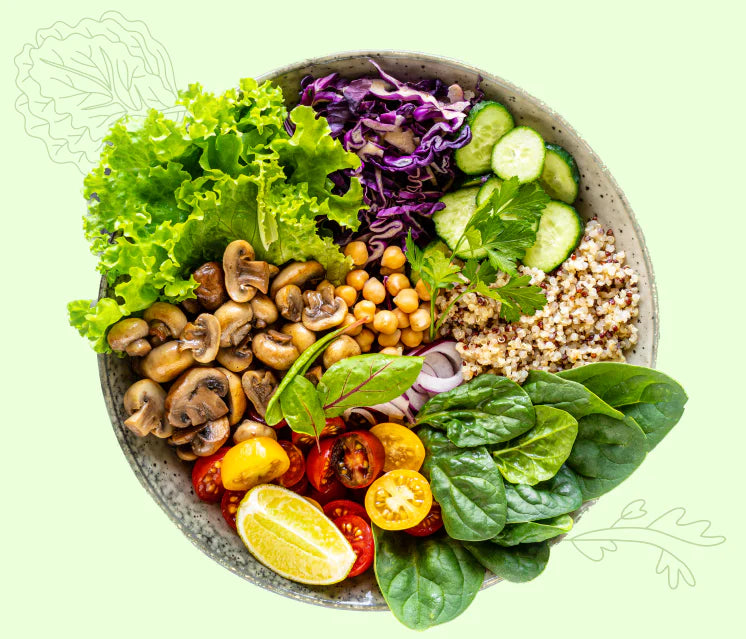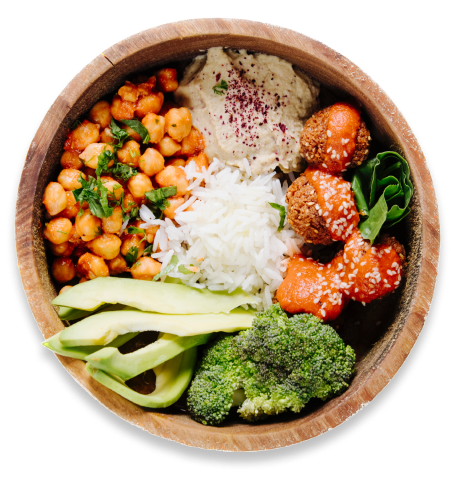Call Us 123456789
Free delivery on order over $200
Your First Day as a Vegan: Simple Steps to Get Started
Buy meal plan
Introduction
Switching to a vegan diet can feel exciting but also a little daunting. Many people start with a mix of curiosity and concern—wondering if they’ll enjoy the food, if they’ll get enough nutrients, or if they’ll struggle with cravings.
Imagine this: You wake up on your first day as a vegan, open your fridge, and suddenly realize your usual breakfast—maybe eggs, yogurt, or buttered toast—isn’t an option anymore. You start questioning what to eat, whether it will be difficult to cook plant-based meals, and if you will miss your usual foods.
The good news is that veganism isn’t about giving things up—it’s about discovering new, delicious options. Many people find that after a few days, they no longer crave their old meals and instead start enjoying the variety of flavors in plant-based foods.
Your first day is all about exploration, not perfection. It’s okay to feel uncertain at first, but by following a simple plan, you’ll make the transition much easier. This guide will walk you through:
- Understanding the basics of veganism
- Planning simple, satisfying meals
- Navigating your first grocery shopping trip
- Handling cravings and challenges
- Staying motivated on your journey
By the end of today, you’ll realize that going vegan isn’t as difficult as it might seem. Let’s get started.
Step 1: Understanding Vegan Basics
Before diving into food choices, it helps to understand what being vegan means. A vegan diet excludes all animal-derived products, including:
- Meat such as chicken, beef, fish, and pork
- Dairy products such as milk, cheese, butter, and yogurt
- Eggs
- Honey and animal-based additives such as gelatin, whey, and casein
Why do people go vegan?
Veganism is growing rapidly. In fact, the number of vegans has increased by 600 percent in the last five years in some countries. People switch for different reasons, including:
- Health benefits – Research shows that plant-based diets can reduce the risk of heart disease by 32 percent, lower the chances of type 2 diabetes by 50 percent, and improve digestion and gut health due to fiber-rich foods.
- Ethical concerns – Many people avoid animal products due to concerns about factory farming and animal cruelty.
- Environmental impact – A study from Oxford University found that going vegan can reduce an individual’s carbon footprint by up to 73 percent, making it one of the most effective ways to help the planet.
There is no single way to be vegan. People follow different styles based on their preferences:
- Whole-food plant-based, which focuses on natural, unprocessed foods such as vegetables, fruits, grains, and legumes.
- Junk-food vegan, which includes more processed foods, such as plant-based burgers, fries, and vegan ice cream.
- Balanced transitioning vegan, which is a mix of both whole foods and convenient vegan alternatives, making the shift easier.
A common concern for new vegans is getting enough protein. Many plant-based foods are rich in protein, including lentils, tofu, chickpeas, and quinoa. By focusing on a variety of plant foods, it is possible to get all the necessary nutrients for a healthy start.
Now that you understand the core principles of veganism, let's put that knowledge into action with a simple meal plan.
Step 2: Planning Your First Vegan Meals
Now that you understand the basics, let’s get into practical meal planning. Your first day as a vegan should be simple, enjoyable, and stress-free.
What Should You Eat?
A vegan diet is full of colorful, nutritious, and delicious foods. Here’s a sample meal plan for your first day:
Breakfast:
- Oatmeal with almond milk, banana, and walnuts. This meal is quick, filling, and full of fiber. A sprinkle of chia seeds adds extra protein.
- Avocado toast on whole-grain bread with cherry tomatoes and sesame seeds. The combination of healthy fats and vitamins provides lasting energy.
- A green smoothie with spinach, frozen berries, chia seeds, and oat milk. This refreshing option is packed with essential nutrients.
Lunch:
- Chickpea salad wrap with avocado, lettuce, and hummus. This is a protein-packed and creamy meal with healthy fats.
- Quinoa and roasted vegetable bowl with tahini dressing. This dish is rich in protein, fiber, and satisfying flavors.
- Vegan chili with lentils, black beans, and diced tomatoes. This hearty meal is packed with plant-based protein and fiber.
Dinner:
- Stir-fried tofu with brown rice, bell peppers, and soy sauce. This is a great protein-rich alternative to chicken stir-fry.
- Whole-wheat pasta with cashew cream sauce and mushrooms. This meal is creamy, comforting, and completely dairy-free.
- Black bean and sweet potato tacos with guacamole. This meal is flavorful and easy to prepare.
Snacks and Quick Bites:
- Hummus with veggie sticks
- Mixed nuts, seeds, and dried fruit
- Dairy-free dark chocolate
- Popcorn with nutritional yeast for a cheesy flavor
Cooking Tips for Beginners:
- Keep it simple by starting with easy, whole-food meals rather than complex recipes.
- Batch cook ingredients in advance to save time during the week.
- Experiment with flavors by using spices such as cumin, smoked paprika, and turmeric to enhance taste.
- Try new plant-based proteins such as tofu, tempeh, lentils, and beans as substitutes for meat.
By following this meal plan and cooking tips, you will find that vegan food is satisfying, delicious, and easy to prepare.
Step 3: Grocery Shopping for the First Time
Grocery shopping as a new vegan can feel overwhelming, but it becomes easier once you know what to look for. The key is to focus on whole, affordable, and versatile ingredients while avoiding over-reliance on expensive specialty products.
Budget-Friendly Vegan Staples
If you're shopping on a budget, focus on whole plant foods, which are usually the most affordable and nutritious options.
- Grains and Carbohydrates – Brown rice, quinoa, oats, whole wheat pasta, whole grain bread, and tortillas.
- Legumes and Beans – Lentils, chickpeas, black beans, kidney beans, and canned or dried beans.
- Vegetables – Carrots, potatoes, spinach, kale, onions, bell peppers, and seasonal produce.
- Fruits – Bananas, apples, oranges, berries, and frozen fruits for smoothies.
- Plant-Based Proteins – Tofu, tempeh, edamame, and seitan.
- Dairy Substitutes – Almond, oat, or soy milk, plant-based yogurts, and nutritional yeast (adds a cheesy flavor).
- Healthy Fats – Avocados, nuts, seeds, tahini, and peanut butter.
- Condiments and Flavor Enhancers – Soy sauce, miso paste, mustard, hot sauce, coconut aminos, and balsamic vinegar.
- Herbs and Spices – Cumin, turmeric, smoked paprika, garlic powder, cinnamon, and oregano.
Navigating the Grocery Store as a Vegan
To make shopping easier, focus on the following sections:
- Produce Section: Load up on fresh vegetables and fruits.
- Bulk Foods Aisle: Buy rice, lentils, oats, and nuts in bulk to save money.
- Canned Goods: Stock up on canned beans, tomatoes, and coconut milk for easy meals.
- Frozen Section: Frozen fruits and vegetables are budget-friendly and last longer.
- Dairy Alternatives: Find plant-based milk, yogurts, and cheese substitutes in the refrigerated section.
- Health Food Aisle: Look for nutritional yeast, tofu, and plant-based protein sources.
A great way to stay on track is to create a simple meal plan for the week and shop accordingly. This will help avoid impulse purchases and reduce food waste.
Step 4: Handling Challenges and Emotional Adjustments
The biggest challenges when going vegan aren’t just about food choices—they also involve social situations, cravings, and emotional adjustments. Here’s how to navigate them.
Cravings and Adjusting to New Foods
Cravings are normal, especially for foods you’ve eaten for years. Instead of ignoring them, find vegan alternatives that satisfy the same textures and flavors.
- If you crave cheese, try nutritional yeast, cashew cheese, or dairy-free cheese brands.
- If you miss meat, experiment with tofu, tempeh, lentils, or plant-based meat substitutes.
- If you want something creamy, use coconut milk, blended cashews, or oat-based products.
- If you’re used to sweet snacks, opt for dark chocolate, fruit with nut butter, or vegan cookies.
Handling Social Situations
Eating out or attending gatherings can feel awkward at first, but preparation helps.
- Check restaurant menus ahead of time to find vegan-friendly options.
- If attending a gathering, offer to bring a plant-based dish everyone can enjoy.
- Politely explain your choice if people ask, but avoid feeling pressured to justify it.
- If family or friends don’t understand your decision, stay patient and focus on your own journey.
- Managing Emotional Challenges
Some people feel isolated or overwhelmed when first going vegan, but this is temporary.
- Remember why you started—whether for health, animals, or the environment.
- Join online vegan communities or social media groups for support.
- Be kind to yourself. If you make a mistake, don’t feel guilty—learning is part of the process.
The emotional shift can be as important as the dietary change, so focus on progress rather than perfection.
Step 5: Staying Motivated and Tracking Progress
Staying motivated is easier when you track your journey, learn from inspiring sources, and celebrate small wins.
Tracking Your Progress
- Keep a food journal to note how you feel after eating plant-based meals.
- Take photos of meals and recipes you enjoy to stay inspired.
- Track any health improvements, such as better digestion, increased energy, or clearer skin.
Books to Stay Inspired
Reading about veganism can help reinforce your commitment. Some great books include:
- How Not to Die by Dr. Michael Greger – Covers the health benefits of a plant-based diet.
- The China Study by T. Colin Campbell – Explores scientific research on plant-based nutrition.
- Eating Animals by Jonathan Safran Foer – A deep dive into ethical and environmental reasons for veganism.
- Vegan for Life by Jack Norris and Virginia Messina – A practical guide to plant-based nutrition.
Conclusion: Long-Term Benefits and Setting Small Goals
Transitioning to a vegan lifestyle is not just about changing what you eat—it’s about adopting a mindset focused on health, sustainability, and ethical choices. While the first day might feel overwhelming, every small step you take contributes to a larger, more meaningful transformation.
Long-Term Benefits of a Vegan Lifestyle
- Embracing a plant-based diet can lead to a range of positive long-term effects:
- Health Improvements: Lower risks of heart disease, diabetes, and high blood pressure. A well-balanced vegan diet can also support weight management and improve digestion.
- Environmental Impact: Reduces greenhouse gas emissions, land use, and water consumption, making a significant difference in combating climate change.
- Ethical Considerations: Contributes to animal welfare by reducing reliance on factory farming and animal exploitation.
- Mental Well-being: Many vegans report feeling more connected to their values, experiencing a greater sense of purpose and fulfillment.
Setting Small, Achievable Goals
Instead of aiming for instant perfection, focus on gradual, sustainable changes:
- Plan One Vegan Meal a Day – Start by swapping out one non-vegan meal for a plant-based alternative.
- Experiment with New Foods – Discover plant-based proteins like lentils, tofu, and quinoa.
- Educate Yourself – Read books, watch documentaries, and follow reputable sources for nutrition advice.
- Find a Support System – Join vegan communities, forums, or social media groups for motivation and inspiration.
- Track Your Progress – Keep a journal or use apps to monitor how your body feels and what foods you enjoy the most.
Final Encouragement
Your first day as a vegan is just the beginning of a journey filled with learning and growth. Mistakes may happen, and that’s okay! What matters most is consistency, curiosity, and a willingness to explore. Start with small steps, build habits at your own pace, and enjoy the process of discovering new flavors, ideas, and benefits that come with a plant-based lifestyle.
What are you waiting for?
It’s time to kickstart your health journey with nourishing and delicious meals to boost your energy and overall health!
